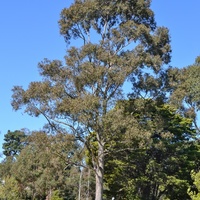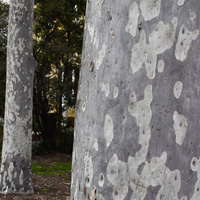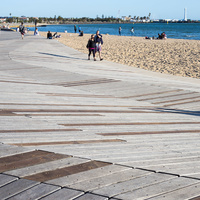Common name: Spotted Gum
Description
Spotted Gum is a timber and honey tree originating in eastern Australia, where it occurs from near the coast to coastal hinterland extending from Victoria, in the continent's south, north through New South Wales, to southeast Queensland.
Included in this description is the closely related but botanically separate Corymbia henryi. Also known as Spotted Gum, it differs only marginally from Corymbia maculata, mainly in its distribution, concentrated in southeast Queensland.
Spotted gums are eucalyptus relatives that can grow into large trees up to 50 m (165 ft) tall, with a trunk diameter approaching 2 m (6.5 ft), though more commonly are around half that size.
It is a handsome tree, with a straight trunk clear of branches for up to two-thirds the tree height, supporting an open, densely leafy crown. The bark is smooth, grey, or light brown and sheds in patches, leaving the trunk mottled or spotted.
Like its eucalyptus relatives, the leaves remain on the tree in all seasons and change shape as the plant matures, from ovate leaves on seedlings and juvenile trees to dark green, narrowly lance-shaped leaves 12 to 25 cm (5 to 10 in) long on adult trees.
Flowering occurs during the cooler months, from the end of autumn through to spring, with small oval buds arising in clusters at the sides and ends of the branches. When open, the flowers have long white filaments surrounding a yellow centre. They are followed by brown, woody, goblet-shaped seed capsules containing tiny flat seed.
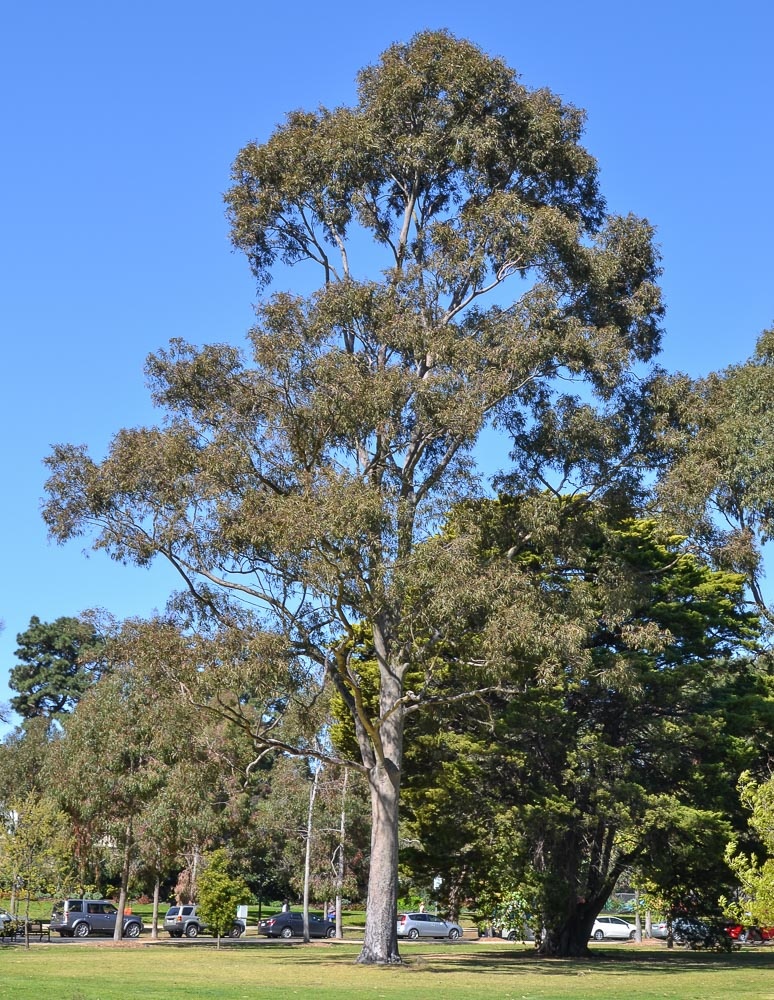
Melbourne, Australia
Use
Spotted Gum is a major honey tree in its native Australia and South Africa, with good nectar flows every three to four years, resulting in yields of up to 60 kgs (132 lbs) of honey per colony per season. The pure honey is extra light to light amber, of good flavour with pleasing caramel undertones, and slow to granulate to a coarse brown grain. The flowers are also a valuable source of pollen for brood-rearing honeybees.
The wood is medium-weight to heavy, in the 750 to 1080 kgs per cubic meter (47 to 67 lbs per cubic foot) range, and has moderate to good natural resistance to rot, decay and wood-boring insects. This puts it in the durable hardwood class, suitable for indoor and outdoor construction. The sapwood is pale and the heartwood light to dark brown, often with attractive fiddleback figuring.
Suitably sized logs are sawn into beams and planks used in construction, including house construction, indoor flooring, outdoor decking, seaside boardwalks, and boat building. Small-diameter logs are widely used for posts and poles, including transmission poles. It is also reputed to be one of the most suitable Australian woods for tool handles. The sawmill off-cuts and branch wood make excellent firewood and charcoal.
The tree's shapely form, smooth, attractively mottled bark and shade make it an excellent candidate for planting as an amenity tree in parks, landscapes and sizeable gardens.
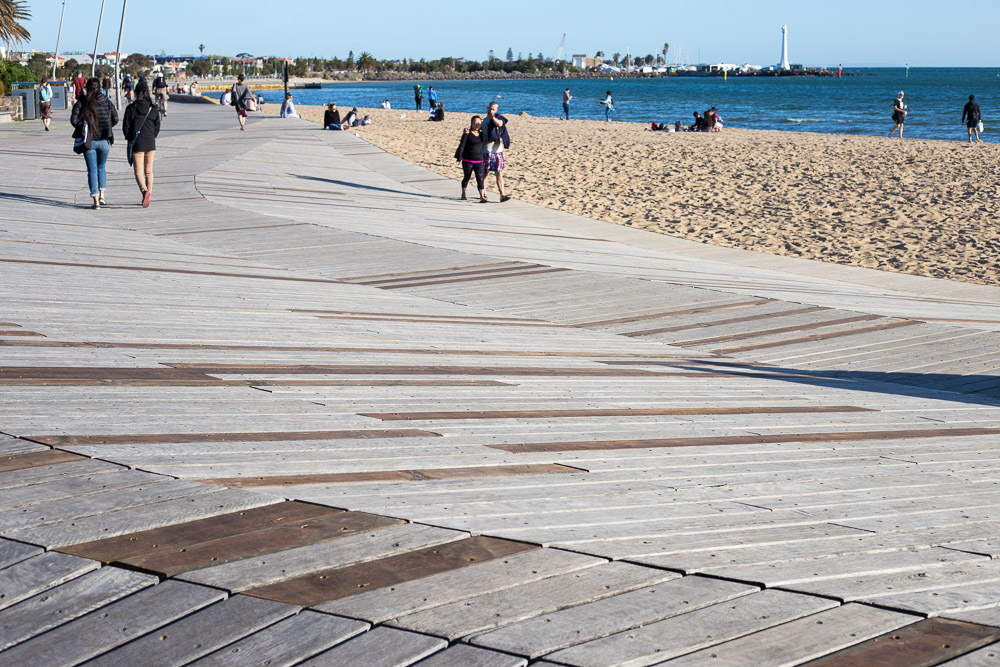
Boardwalk made of spotted gum wood (Melbourne, Australia)
Climate
Grows naturally in humid subtropical and warm-temperate climates, generally areas with annual lows of 8 to 19°C, annual highs of 18 to 29°C, annual rainfall of 600 to 1800 mm and a dry season of 5 months or less, extending to 8 months or more with irrigation or groundwater.
Growing
New plants are usually started from seed, which remain viable for several years under cool, dry, air-tight storage. The seed benefit from soaking in water before sowing, and most will germinate within a week. They are best sown in containers with a free-draining potting mix, and the seedlings cared for in a nursery for 4 to 5 months, or until about 30 to 40 cm (1 to 1.3 ft) in height.
Spotted gum trees perform best on free-draining clay-loam, loam, silt-loam and sandy-loam soils of a moderately acid to neutral nature, generally with a pH of 5.5 to 7.5 and on sites with full sun exposure.
Problem features
Spotted Gum is recorded as naturalised in parts of Australia outside of its natural range. Still, there does not appear to be any record of it anywhere as a serious weed or invasive species.
Where it grows
References
Books
-
Blake, S. T. & Roff, C. 1987, The honey flora of Queensland, 3rd ed., Queensland Department of Primary Industries (QLD DPI), Brisbane
-
Boland, D. & Brooker, I. & McDonald, M. W. 2006, Forest trees of Australia, 5th ed., CSIRO Publishing (Ensis), Melbourne
-
Clarke, B. & McLeod, I. & Vercoe, T. 2009, Trees for farm Forestry : 22 Promising Species, Rural Industries Research and Development Corporation (RIRDC), Wagga Wagga, New South Wales
-
Clemson, A. 1985, Honey and pollen flora, New South Wales Department of Agriculture, Inkata Press, Melbourne
-
Crane, E., Walker, P. & Day, R. 1984, Directory of important world honey sources, International Bee Research Association, London
-
F. R. Beuhne 1922, Honey flora of Victoria, Melbourne Albert J. Mullett, Govt. printer
-
Jacobs M. R. 1979, Eucalypts for planting, Food and Agriculture Organization of the United Nations (FAO), Rome
-
Randall, R. P. 2002, A global compendium of weeds, R.G. and F.J. Richardson Press, Melbourne
-
Randall, R. P. 2007, The introduced flora of Australia and its weed status, Cooperative Research Centre for Australian Weed Management, Glen Osmond, South Australia
-
Scheffer, T. C & Morrell, J. J. 1998, Natural durability of wood : a worldwide checklist of species, Forest Research Laboratory, Oregon State University, Corvallis, Oregon
-
Streets, R. J. & Troup, R. S. 1962, Exotic forest trees in the British Commonwealth, Oxford University Press, Oxford, England
-
Webb, D. B. 1984, A Guide to species selection for tropical and sub-tropical plantations, 2nd ed., Unit of Tropical Silviculture, Commonwealth Forestry Institute, University of Oxford, Oxfordshire
